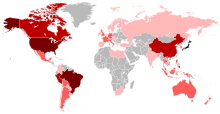
Back يابانيو المهجر Arabic Nikkeijin Catalan Nikkei Spanish مهاجران ژاپنی Persian Diaspora japonaise French Japán diaszpóra Hungarian Diaspora Jepang ID Diaspora giapponese Italian 日系人 Japanese 일본계 외국인 Korean
日系人 Nikkeijin | |
|---|---|
 | |
| Total population | |
| About 4,000,000 (2022)[1] | |
| Regions with significant populations | |
| Brazil | 2,000,000[2] (2022) |
| United States | 1,550,875[3] (2020) |
| Canada | 129,425[4] (2021) |
| Philippines | 120,000[5][6][better source needed] |
| Peru | 103,182[7] (2021) |
| China | 102,066[8] (2022)note |
| Australia | 94,942[8] (2022)note |
| Mexico | 86,143[9] (2022) |
| Thailand | 78,431[8] (2022)note |
| Argentina | 76,440[10] (2020) |
| United Kingdom | 65,022[8] (2022)note |
| Germany | 42,266[8] (2022)note |
| South Korea | 41,717[8] (2022)note |
| France | 36,104[8] (2022)note |
| Singapore | 32,743[8] (2022)note |
| Malaysia | 24,545[8] (2022)note |
| Vietnam | 21,819[8] (2022)note |
| Taiwan | 20,345[8] (2022)note |
| Micronesia | 20,000[11][better source needed] (2018) |
| Related ethnic groups | |
| Ryukyuan diaspora | |
Note: For this country, only the number of residents with Japanese nationality is shown, since the number of naturalized Japanese people and their descendants is unknown. | |
The Japanese diaspora and its individual members, known as Nikkei (日系) or as Nikkeijin (日系人), comprise the Japanese emigrants from Japan (and their descendants) residing in a country outside Japan. Emigration from Japan was recorded as early as the 15th century to the Philippines,[12][13][14][15] but did not become a mass phenomenon until the Meiji period (1868–1912), when Japanese emigrated to the Philippines[16] and to the Americas.[17][18] There was significant emigration to the territories of the Empire of Japan during the period of Japanese colonial expansion (1875–1945); however, most of these emigrants repatriated to Japan after the 1945 surrender of Japan ended World War II in Asia.[19]
According to the Association of Nikkei and Japanese Abroad, about 4 million Nikkei live in their adopted countries.[1] The largest of these foreign communities are in Brazil, the United States, the Philippines,[20] China, Canada and Peru. Descendants of emigrants from the Meiji period still maintain recognizable communities in those countries, forming separate ethnic groups from Japanese people in Japan.[21] The largest of these foreign communities are in the Brazilian states of São Paulo and Paraná.[citation needed] There are also significant cohesive Japanese communities in the Philippines, Peru and in the American state of Hawaiʻi.[citation needed] Nevertheless, most emigrant Japanese are largely assimilated outside of Japan.[citation needed]
As of 2022[update], the Japanese Ministry of Foreign Affairs reported the five countries with the highest number of Japanese expatriates as the United States (418,842), China (102,066), Australia (94,942), Thailand (78,431) and Canada (74,362).[8]
- ^ a b "Who are "Nikkei & Japanese Abroad"?". The Association of Nikkei and Japanese Abroad. Retrieved 22 May 2023.
- ^ "Japan-Brazil Relations (Basic Data)". Ministry of Foreign Affairs of Japan. Retrieved 22 May 2023.
- ^ "American Community Survey: Asian Alone or in Any Combination by Selected Groups". United States Census Bureau. Retrieved 22 May 2023.
- ^ "Ethnic or cultural origin by gender and age: Canada, provinces and territories". Statistics Canada. 26 October 2022. Retrieved 22 May 2023.
- ^ Agnote, Dario (11 October 2006). "A glimmer of hope for castoffs". The Japan Times. Archived from the original on 7 June 2011. Retrieved 9 August 2016.
- ^ Ohno, Shun (2006). "The Intermarried issei and mestizo nisei in the Philippines". In Adachi, Nobuko (ed.). Japanese diasporas: Unsung pasts, conflicting presents, and uncertain futures. Routledge. p. 97. ISBN 978-1-135-98723-7.
- ^ "Japan-Peru Relations (Basic Data)". Ministry of Foreign Affairs of Japan. Retrieved 22 May 2023.
- ^ a b c d e f g h i j k l 海外在留邦人数調査統計 [Annual Report of Statistics on Japanese Nationals Overseas] (PDF). Ministry of Foreign Affairs of Japan (in Japanese). 1 October 2022.
- ^ "Japan-Mexico Relations". Ministry of Foreign Affairs of Japan. Retrieved 22 May 2023.
- ^ "Japan-Argentina Relations (Basic Data)". Ministry of Foreign Affairs of Japan. Retrieved 22 May 2023.
- ^ Horie, Ryoichi (20 July 2018). "The Voice of the Ambassador to Micronesia". Association for Promotion of International Cooperation. Retrieved 22 May 2023.
- ^ "Ancient Japanese pottery in Boljoon town". 30 May 2011.
- ^ Manansala, Paul Kekai (5 September 2006). "Quests of the Dragon and Bird Clan: Luzon Jars (Glossary)".
- ^ Cole, Fay-Cooper (1912). "Chinese Pottery in the Philippines" (PDF). Field Museum of Natural History. Anthropological Series. 12 (1).
- ^ "Philippines History, Culture, Civilization and Technology, Filipino". asiapacificuniverse.com.
- ^ さや・白石; Shiraishi, Takashi (1993). The Japanese in Colonial Southeast Asia. SEAP Publications. ISBN 9780877274025.
- ^ Ministry of Foreign Affairs (MOFA), Japan: Japan-Mexico relations
- ^ Palm, Hugo. "Desafíos que nos acercan," Archived 15 April 2009 at the Wayback Machine El Comercio (Lima, Peru). 12 March 2008.
- ^ Azuma, Eiichiro (2005). "Brief Historical Overview of Japanese Emigration". International Nikkei Research Project. Archived from the original on 19 February 2007. Retrieved 2 February 2007.
- ^ Furia, Reiko (1993). "The Japanese Community Abroad: The Case of Prewar Davao in the Philippines". In Saya Shiraishi; Takashi Shiraishi (eds.). The Japanese in Colonial Southeast Asia. Southeast Asia Program, Cornell University Publications. p. 157. ISBN 978-0-87727-402-5. Retrieved 30 May 2016.
- ^ Shoji, Rafael (2005). "Book Review" (PDF). Journal of Global Buddhism 6. Archived from the original (PDF) on 3 March 2016. Retrieved 2 February 2007.
© MMXXIII Rich X Search. We shall prevail. All rights reserved. Rich X Search